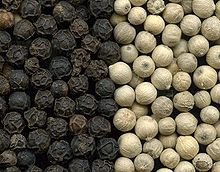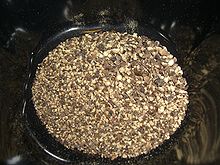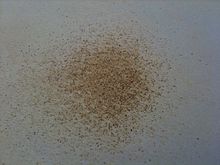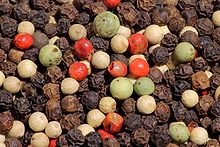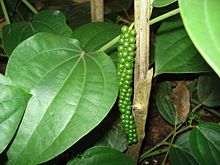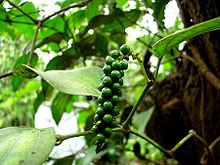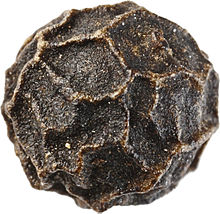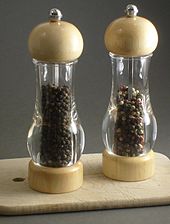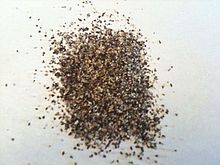- Black pepper
-
Black pepper 
Pepper plant with immature peppercorns Scientific classification Kingdom: Plantae (unranked): Angiosperms (unranked): Magnoliids Order: Piperales Family: Piperaceae Genus: Piper Species: P. nigrum Binomial name Piper nigrum
L.[1]Black pepper (Piper nigrum) is a flowering vine in the family Piperaceae, cultivated for its fruit, which is usually dried and used as a spice and seasoning. The fruit, known as a peppercorn when dried, is approximately 5 millimetres (0.20 in) in diameter, dark red when fully mature, and, like all drupes, contains a single seed. Peppercorns, and the powdered pepper derived from grinding them, may be described simply as pepper, or more precisely as black pepper, white pepper, or green pepper. Green peppercorns are simply the immature black peppercorns.
Black peppers are native to India and are extensively cultivated there and elsewhere in tropical regions. Currently Vietnam is by far the world's largest producer and exporter of pepper, producing 34% of the world's Piper nigrum crop as of 2008.
Dried ground pepper has been used since antiquity for both its flavour and as a medicine. Black pepper is the world's most traded spice. It is one of the most common spices added to European cuisine and its descendants. The spiciness of black pepper is due to the chemical piperine. It may be found on nearly every dinner table in the industrialized world, often alongside table salt.
Contents
Etymology
The word "pepper" is ultimately derived from the Tamil/Malayalam word for long pepper, pippali.[2][3][4] Black pepper is marica. Ancient Greek and Latin borrowed pippali to refer to either via the Latin piper which was used by the Romans to refer both to pepper and long pepper, as the Romans erroneously believed that both of these spices were derived from the same plant.[citation needed] The English word for pepper is derived from the Old English pipor. The Latin word is also the source of Italian pepe, Dutch peper, German Pfeffer, French poivre, and other similar forms. In the 16th century, pepper started referring to the unrelated New World chile peppers as well. "Pepper" was used in a figurative sense to mean "spirit" or "energy" at least as far back as the 1840s; in the early 20th century, this was shortened to pep.[5]
Varieties
Black pepper
Black pepper is produced from the still-green unripe drupes of the pepper plant. The drupes are cooked briefly in hot water, both to clean them and to prepare them for drying. The heat ruptures cell walls in the pepper, speeding the work of browning enzymes during drying. The drupes are dried in the sun or by machine for several days, during which the pepper around the seed shrinks and darkens into a thin, wrinkled black layer. Once dried, the spice is called black peppercorn. On some estates, the berries are separated from the stem by foot and then sun dried without the boiling process.
Once the peppercorns are dried, pepper spirit & oil can be extracted from the berries by crushing it. Pepper spirit is used in famous beverages like Coca-Cola and many other medicinal or beauty products. Pepper oil is also used as an ayurvedic massage oil or used in beauty and herbal treatments.
White pepper
White pepper consists of the seed of the pepper plant alone, with the darker coloured skin of the pepper fruit removed. This is usually accomplished by a process known as retting, where fully ripe red pepper berries are soaked in water for about a week, during which the flesh of the pepper softens and decomposes. Rubbing then removes what remains of the fruit, and the naked seed is dried. Alternative processes are used for removing the outer pepper from the seed, including decortication, the removal of the outer layer through mechanical, chemical or biological methods.[6]
White pepper is sometimes used in dishes like Salad, Chinese Cooking, light-coloured sauces or mashed potatoes, where ground black pepper would visibly stand out. They have differing flavour due to the presence of certain compounds in the outer fruit layer of the drupe that are not found in the seed.
Green pepper
Green pepper, like black, is made from the unripe drupes. Dried green peppercorns are treated in a way that retains the green color, such as treatment with sulfur dioxide, canning or freeze-drying. Pickled peppercorns, also green, are unripe drupes preserved in brine or vinegar. Fresh, unpreserved green pepper drupes, largely unknown in the West, are used in some Asian cuisines, particularly Thai cuisine.[7] Their flavour has been described as piquant and fresh, with a bright aroma.[8] They decay quickly if not dried or preserved.
Orange pepper and red pepper
A product called orange pepper or red pepper consists of ripe red pepper drupes preserved in brine and vinegar. Ripe red peppercorns can also be dried using the same colour-preserving techniques used to produce green pepper.[9] Pink pepper from Piper nigrum is distinct from the more-common dried pink peppercorns, which are the fruits of a plant from a different family, the Peruvian pepper tree, Schinus molle, and its relative the Brazilian pepper tree, Schinus terebinthifolius.
The bark of Drimys winteri (Canelo or Winter's Bark) is used as a substitute for pepper in cold and temperate regions of Chile and Argentina where it is easily available. In New Zealand the seeds of Kawakawa (Macropiper excelsum) are used as pepper and the leaves of Pseudowintera colorata (Mountain horopito) are used as a replacement for pepper.
Region of origin
Peppercorns are often categorised under a label describing their region or port of origin. Two well-known types come from India's Malabar Coast: Malabar pepper and Tellicherry pepper. Tellicherry is a higher-grade pepper, made from the largest, ripest 10% of fruits from Malabar plants grown on Mount Tellicherry.[10] Sarawak pepper is produced in the Malaysian portion of Borneo.
Lampung pepper on Indonesia's island of Sumatra. White Muntok pepper is another Indonesian product. Vietnam peppers are white and black pepper and come from Ba Ria - Vung Tau, Chu Se and Binh Phuoc.[11]
Plant
The pepper plant is a perennial woody vine growing to four metres in height on supporting trees, poles, or trellises. It is a spreading vine, rooting readily where trailing stems touch the ground. The leaves are alternate, entire, five to ten centimetres long and three to six centimetres broad. The flowers are small, produced on pendulous spikes four to eight centimetres long at the leaf nodes, the spikes lengthening to seven to 15 centimetres as the fruit matures.[12] The fruit of the black pepper is called a drupe and when dried it is a peppercorn.
Black pepper is grown in soil that is neither too dry nor susceptible to flooding, moist, well-drained and rich in organic matter (the vines do not do too well over an altitude of 3000 ft above sea level). The plants are propagated by cuttings about 40 to 50 centimetres long, tied up to neighbouring trees or climbing frames at distances of about two metres apart; trees with rough bark are favoured over those with smooth bark, as the pepper plants climb rough bark more readily. Competing plants are cleared away, leaving only sufficient trees to provide shade and permit free ventilation. The roots are covered in leaf mulch and manure, and the shoots are trimmed twice a year. On dry soils the young plants require watering every other day during the dry season for the first three years. The plants bear fruit from the fourth or fifth year, and typically continue to bear fruit for seven years. The cuttings are usually cultivars, selected both for yield and quality of fruit. A single stem will bear 20 to 30 fruiting spikes. The harvest begins as soon as one or two fruits at the base of the spikes begin to turn red, and before the fruit is fully mature, and still hard; if allowed to ripen completely , the fruit lose pungency, and ultimately fall off and are lost. The spikes are collected and spread out to dry in the sun, then the peppercorns are stripped off the spikes.[12]
Black pepper is native to India.[13][14] Within the genus Piper, it is most closely related to other Asian species such as Piper caninum.[14]
History
Pepper has been used as a spice in India since prehistoric times. Pepper is native to India and has been known to Indian cooking since at least 2000 BCE.[15] J. Innes Miller notes that while pepper was grown in southern Thailand and in Malaysia, its most important source was India, particularly the Malabar Coast, in what is now the state of Kerala.[16] Peppercorns were a much-prized trade good, often referred to as "black gold" and used as a form of commodity money. The term "peppercorn rent" still exists today.
The ancient history of black pepper is often interlinked with (and confused with) that of long pepper, the dried fruit of closely related Piper longum. The Romans knew of both and often referred to either as just "piper". In fact, it was not until the discovery of the New World and of chile peppers that the popularity of long pepper entirely declined. Chile peppers, some of which when dried are similar in shape and taste to long pepper, were easier to grow in a variety of locations more convenient to Europe.
After the Middle Ages, virtually all of the black pepper found in Europe, the Middle East, and North Africa was from India's Malabar region. By the 16th century, due to the Portuguese influence, pepper was also being grown in Java, Sunda, Sumatra, Madagascar, Malaysia, and elsewhere in Southeast Asia, but these areas traded mainly with China, or used the pepper locally.[17] Ports in the Malabar area also served as a stop-off point for much of the trade in other spices from farther east in the Indian Ocean.
Black pepper, along with other spices from India and lands farther east, changed the course of world history. It was in some part the preciousness of these spices that led to the Portuguese efforts to find a sea route to India during the age of discovery and consequently to the Portuguese colonial occupation of that country, as well as the European discovery and colonisation of the Americas.[18]
Ancient times
Black peppercorns were found stuffed in the nostrils of Ramesses II, placed there as part of the mummification rituals shortly after his death in 1213 BCE.[19] Little else is known about the use of pepper in ancient Egypt and how it reached the Nile from India.
Pepper (both long and black) was known in Greece at least as early as the 4th century BCE, though it was probably an uncommon and expensive item that only the very rich could afford. Trade routes of the time were by land, or in ships which hugged the coastlines of the Arabian Sea. Long pepper, growing in the north-western part of India, was more accessible than the black pepper from further south; this trade advantage, plus long pepper's greater spiciness, probably made black pepper less popular at the time.
By the time of the early Roman Empire, especially after Rome's conquest of Egypt in 30 BCE, open-ocean crossing of the Arabian Sea directly to southern India's Malabar Coast was near routine. Details of this trading across the Indian Ocean have been passed down in the Periplus of the Erythraean Sea. According to the Roman geographer Strabo, the early Empire sent a fleet of around 120 ships on an annual one-year trip to India and back. The fleet timed its travel across the Arabian Sea to take advantage of the predictable monsoon winds. Returning from India, the ships travelled up the Red Sea, from where the cargo was carried overland or via the Nile Canal to the Nile River, barged to Alexandria, and shipped from there to Italy and Rome. The rough geographical outlines of this same trade route would dominate the pepper trade into Europe for a millennium and a half to come.
With ships sailing directly to the Malabar coast, black pepper was now travelling a shorter trade route than long pepper, and the prices reflected it. Pliny the Elder's Natural History tells us the prices in Rome around 77 CE: "Long pepper ... is fifteen denarii per pound, while that of white pepper is seven, and of black, four." Pliny also complains "there is no year in which India does not drain the Roman Empire of fifty million sesterces," and further moralises on pepper:
It is quite surprising that the use of pepper has come so much into fashion, seeing that in other substances which we use, it is sometimes their sweetness, and sometimes their appearance that has attracted our notice; whereas, pepper has nothing in it that can plead as a recommendation to either fruit or berry, its only desirable quality being a certain pungency; and yet it is for this that we import it all the way from India! Who was the first to make trial of it as an article of food? and who, I wonder, was the man that was not content to prepare himself by hunger only for the satisfying of a greedy appetite? (N.H. 12.14)[20]
Black pepper was a well-known and widespread, if expensive, seasoning in the Roman Empire. Apicius' De re coquinaria, a 3rd-century cookbook probably based at least partly on one from the 1st century CE, includes pepper in a majority of its recipes. Edward Gibbon wrote, in The History of the Decline and Fall of the Roman Empire, that pepper was "a favourite ingredient of the most expensive Roman cookery".
Postclassical Europe
Pepper was so valuable that it was often used as collateral or even currency. In the Dutch language, "pepper expensive" (peperduur) is an expression for something very expensive. The taste for pepper (or the appreciation of its monetary value) was passed on to those who would see Rome fall. It is said[by whom?] that Alaric the Visigoth and Attila the Hun each demanded from Rome a ransom of more than a ton of pepper when they besieged the city in 5th century. After the fall of Rome, others took over the middle legs of the spice trade, first the Persians and then the Arabs; Innes Miller cites the account of Cosmas Indicopleustes, who travelled east to India, as proof that "pepper was still being exported from India in the sixth century".[21] By the end of the Early Middle Ages, the central portions of the spice trade were firmly under Islamic control. Once into the Mediterranean, the trade was largely monopolised by Italian powers, especially Venice and Genoa. The rise of these city-states was funded in large part by the spice trade.
A riddle authored by Saint Aldhelm, a 7th-century Bishop of Sherborne, sheds some light on black pepper's role in England at that time:
I am black on the outside, clad in a wrinkled cover,
Yet within I bear a burning marrow.
I season delicacies, the banquets of kings, and the luxuries of the table,
Both the sauces and the tenderized meats of the kitchen.
But you will find in me no quality of any worth,
Unless your bowels have been rattled by my gleaming marrow.[22]It is commonly believed that during the Middle Ages, pepper was used to conceal the taste of partially rotten meat. There is no evidence to support this claim, and historians view it as highly unlikely: in the Middle Ages, pepper was a luxury item, affordable only to the wealthy, who certainly had unspoiled meat available as well.[23] In addition, people of the time certainly knew that eating spoiled food would make them sick. Similarly, the belief that pepper was widely used as a preservative is questionable: it is true that piperine, the compound that gives pepper its spiciness, has some antimicrobial properties, but at the concentrations present when pepper is used as a spice, the effect is small.[24] Salt is a much more effective preservative, and salt-cured meats were common fare, especially in winter. However, pepper and other spices probably did play a role in improving the taste of long-preserved meats.
Its exorbitant price during the Middle Ages—and the monopoly on the trade held by Italy—was one of the inducements which led the Portuguese to seek a sea route to India. In 1498, Vasco da Gama became the first person to reach India by sailing around Africa; asked by Arabs in Calicut (who spoke Spanish and Italian) why they had come, his representative replied, "we seek Christians and spices". Though this first trip to India by way of the southern tip of Africa was only a modest success, the Portuguese quickly returned in greater numbers and eventually gained much greater control of trade on the Arabian sea. It was given additional legitimacy (at least from a European imperialistic perspective) by the 1494 Treaty of Tordesillas, which granted Portugal exclusive rights to the half of the world where black pepper originated.
The Portuguese proved unable to maintain their stranglehold on the spice trade for long. The old Arab and Venetian trade networks successfully 'smuggled' enormous quantities of spices through the patchy Portuguese blockade, and pepper once again flowed through Alexandria and Italy, as well as around Africa. In the 17th century, the Portuguese lost almost all of their valuable Indian Ocean trade to the Dutch and the English who, taking advantage from the Spanish ruling over Portugal (1580–1640), occupied by force almost all Portuguese dominations in the area. The pepper ports of Malabar began to trade increasingly with the Dutch in the period 1661–1663.
 Pepper harvested for the European trader, from a manuscript Livre des merveilles de Marco Polo (The book of the marvels of Marco Polo)
Pepper harvested for the European trader, from a manuscript Livre des merveilles de Marco Polo (The book of the marvels of Marco Polo)
As pepper supplies into Europe increased, the price of pepper declined (though the total value of the import trade generally did not). Pepper, which in the early Middle Ages had been an item exclusively for the rich, started to become more of an everyday seasoning among those of more average means. Today, pepper accounts for one-fifth of the world's spice trade.[25]
China
It is possible that black pepper was known in China in the 2nd century BCE, if poetic reports regarding an explorer named Tang Meng (唐蒙) are correct. Sent by Emperor Wu to what is now south-west China, Tang Meng is said to have come across something called jujiang or "sauce-betel". He was told it came from the markets of Shu, an area in what is now the Sichuan province. The traditional view among historians is that "sauce-betel" is a sauce made from betel leaves, but arguments have been made that it actually refers to pepper, either long or black.[26]
In the 3rd century AD, black pepper made its first definite appearance in Chinese texts, as hujiao or "foreign pepper". It does not appear to have been widely known at the time, failing to appear in a 4th-century work describing a wide variety of spices from beyond China's southern border, including long pepper.[27] By the 12th century, however, black pepper had become a popular ingredient in the cuisine of the wealthy and powerful, sometimes taking the place of China's native Sichuan pepper (the tongue-numbing dried fruit of an unrelated plant).
Marco Polo testifies to pepper's popularity in 13th-century China when he relates what he is told of its consumption in the city of Kinsay (Hangzhou): "... Messer Marco heard it stated by one of the Great Kaan's officers of customs that the quantity of pepper introduced daily for consumption into the city of Kinsay amounted to 43 loads, each load being equal to 223 lbs."[28] Marco Polo is not considered a very reliable source regarding China, and this second-hand data may be even more suspect, but if this estimated 10,000 pounds (4,500 kg) a day for one city is anywhere near the truth, China's pepper imports may have dwarfed Europe's.
As medicine
Like many eastern spices, pepper was historically both a seasoning and a medicine. Long pepper, being stronger, was often the preferred medication, but both were used.
Black Pepper (or perhaps long pepper) was believed to cure illness such as constipation, diarrhea, earache, gangrene, heart disease, hernia, hoarseness, indigestion, insect bites, insomnia, joint pain, liver problems, lung disease, oral abscesses, sunburn, tooth decay, and toothaches.[29] Various sources from the 5th century onward also recommend pepper to treat eye problems, often by applying salves or poultices made with pepper directly to the eye. There is no current medical evidence that any of these treatments has any benefit; pepper applied directly to the eye would be quite uncomfortable and possibly damaging.[30] Nevertheless, Black pepper either powdered or its decoction is widely used in traditional Indian medicine and as a home remedy for relief from sore throat, throat congestion, cough etc.
Pepper is known to cause sneezing. Some sources say that piperine, a substance present in black pepper, irritates the nostrils, causing the sneezing;[31] Few, if any, controlled studies have been carried out to answer the question. It has been shown that piperine can dramatically increase absorption of selenium, vitamin B, beta-carotene and curcumin as well as other nutrients.[32]
As a medicine, pepper appears in the Buddhist Samaññaphala Sutta, chapter five, as one of the few medicines allowed to be carried by a monk.[33]
Pepper contains small amounts of safrole, a mildly carcinogenic compound.[32] Also, it is eliminated from the diet of patients having abdominal surgery and ulcers because of its irritating effect upon the intestines,[34] being replaced by what is referred to as a bland diet. However, extracts from black pepper have been found to have antioxidant properties[35] and anti-carcinogenic effects, especially when compared to chili.[36]
Piperine present in black pepper acts as a thermogenic compound. Piperine enhances the thermogenesis of lipid and accelerates[37] energy metabolism in the body and also increases the serotonin and beta-endorphin production in the brain.
Piperine and other components from black pepper may also be helpful in treating vitiligo,[38] although when combined with UV radiation should be staggered due to the effect of light on the compound.[39]
Flavour
Pepper gets its spicy heat mostly from the piperine compound, which is found both in the outer fruit and in the seed. Black pepper contains between 4.6% and 9.7% piperine by mass, and white pepper slightly more than that.[40] Refined piperine, by weight, is about one percent as hot as the capsaicin in chili peppers.[citation needed] The outer fruit layer, left on black pepper, also contains important odour-contributing terpenes including pinene, sabinene, limonene, caryophyllene, and linalool, which give citrusy, woody, and floral notes. These scents are mostly missing in white pepper, which is stripped of the fruit layer. White pepper can gain some different odours (including musty notes) from its longer fermentation stage.[41]
Pepper loses flavour and aroma through evaporation, so airtight storage helps preserve pepper's original spiciness longer. Pepper can also lose flavour when exposed to light, which can transform piperine into nearly tasteless isochavicine.[41] Once ground, pepper's aromatics can evaporate quickly; most culinary sources recommend grinding whole peppercorns immediately before use for this reason. Handheld pepper mills (or "pepper grinders"), which mechanically grind or crush whole peppercorns, are used for this, sometimes instead of pepper shakers, dispensers of pre-ground pepper. Spice mills such as pepper mills were found in European kitchens as early as the 14th century, but the mortar and pestle used earlier for crushing pepper remained a popular method for centuries after as well.[42]
World trade
Peppercorns (dried black pepper) are, by monetary value, the most widely traded spice in the world, accounting for 20 percent of all spice imports in 2002. The price of pepper can be volatile, and this figure fluctuates a great deal year to year; for example, pepper made up 39 percent of all spice imports in 1998.[43] By weight, slightly more chilli peppers are traded worldwide than peppercorns. The International Pepper Exchange is located in Kochi, India. Participation on the IPE however is domestic with regulatory restrictions on international membership on local exchanges; something common to almost all Asian commodity exchanges.
As of 2008, Vietnam is the world's largest producer and exporter of pepper, producing 34% of the world's Piper nigrum. Other major producers include India (19%), Brazil (13%), Indonesia (9%), Malaysia (8%), Sri Lanka (6%), China (6%), and Thailand (4%). Global pepper production peaked in 2003 with over 355,000 t (391,000 short tons), but has fallen to just over 271,000 t (299,000 short tons) by 2008 due to a series of issues including poor crop management, disease and weather. Vietnam dominates the export market, using almost none of its production domestically; however its 2007 crop fell by nearly 10% from the previous year to about 90,000 t (99,000 short tons). Similar crop yields occurred in 2007 across the other pepper producing nations as well.[44]
Notes
- ^ "Piper nigrum information from NPGS/GRIN". www.ars-grin.gov. http://www.ars-grin.gov/cgi-bin/npgs/html/taxon.pl?28589. Retrieved 2 March 2008.
- ^ http://books.google.com/books?id=kt1Rp1eXRxoC&pg=PA137&dq=pippali+dravidian&hl=en&ei=MgZ6TdzdA4bOswbyuqziBw&sa=X&oi=book_result&ct=result&resnum=2&ved=0CC4Q6AEwAQ#v=onepage&q=pippali%20dravidian&f=false
- ^ http://books.google.com/books?id=UmMnh1XKJjQC&pg=PA14&dq=pippali+dravidian&hl=en&ei=MgZ6TdzdA4bOswbyuqziBw&sa=X&oi=book_result&ct=result&resnum=6&ved=0CEEQ6AEwBQ#v=onepage&q=pippali%20dravidian&f=false
- ^ http://books.google.com/books?id=LnoREHdzxt8C&pg=PA14&dq=pippali+dravidian&hl=en&ei=MgZ6TdzdA4bOswbyuqziBw&sa=X&oi=book_result&ct=result&resnum=7&ved=0CEYQ6AEwBg#v=onepage&q=pippali%20dravidian&f=false
- ^ Douglas Harper's Online Etymology Dictionary entries for pepper and pep. Retrieved 13 November 2005.
- ^ "Cleaner technology for white pepper production". The Hindu Business line. 27 March 2008. http://www.thehindubusinessline.com/2008/03/27/stories/2008032751741300.htm. Retrieved 29 January 2009.
- ^ See Thai Ingredients Glossary. Retrieved 6 November 2005.
- ^ Ochef, Using fresh green peppercorns. Retrieved 6 November 2005.
- ^ Katzer, Gernot (2006). Pepper. Gernot Katzer's Spice Pages. Retrieved 12 August 2006.
- ^ Peppercorns, from Penzeys Spices. Retrieved 17 October 2006.
- ^ Pepper varieties information from A Cook's Wares. Retrieved 6 November 2005.
- ^ a b "BLACK PEPPER" (PDF). The Philippine Department of Agriculture. 20 November 2006. http://www.da.gov.ph/wps/wcm/resources/file/ebb81841763712b/black%20pepper.pdf. Retrieved 29 January 2009.[dead link]
- ^ "Piper nigrum Linnaeus". Flora of China. http://www.efloras.org/florataxon.aspx?flora_id=2&taxon_id=200005581.
- ^ a b Jaramillo, M. Alejandra; Manos (2001). "Phylogeny and Patterns of Floral Diversity in the Genus Piper (Piperaceae)". American Journal of Botany 88 (4): 706. doi:10.2307/2657072. PMID 11302858. http://www.amjbot.org/cgi/content/full/88/4/706.
- ^ Davidson & Saberi 178
- ^ J. Innes Miller, The Spice Trade of the Roman Empire (Oxford: Clarendon Press, 1969), p. 80
- ^ Dalby p. 93.
- ^ Jack Turner (10 August 2004). Spice. Random House. ISBN 0375407219.
- ^ Stephanie Fitzgerald (8 September 2008). Ramses II, Egyptian Pharaoh, Warrior, and Builder. Compass Point Books. p. 88. ISBN 075653836X. http://books.google.com/?id=J8mGcvFkatIC&pg=PT24&lpg=PT24&dq=Rameses+Peppercorn. Retrieved 29 January 2008.
- ^ From Bostock and Riley's 1855 translation. Text online.
- ^ Innes Miller, The Spice Trade, p. 83
- ^ Translation from Turner, p 94. The riddle's answer is of course pepper.
- ^ Dalby p. 156; also Turner pp. 108–109, though Turner does go on to discuss spices (not pepper specifically) being used to disguise the taste of partially spoiled wine or ale.
- ^ H. J. D. Dorman and S. G. Deans (2000). "Antimicrobial agents from plants: antibacterial activity of plant volatile oils". Journal of Applied Microbiology 88 (2): 308. doi:10.1046/j.1365-2672.2000.00969.x. PMID 10736000.. Full text at Blackwell website; purchase required. "Spices, which are used as integral ingredients in cuisine or added as flavouring agents to foods, are present in insufficient quantities for their antimicrobial properties to be significant."
- ^ Jaffee, p. 10.
- ^ Dalby pp. 74–75. The argument that jujiang was long pepper goes back to the 4th century CE botanical writings of Ji Han; Hui-lin Li's 1979 translation of and commentary on Ji Han's work makes the case that it was piper nigrum.
- ^ Dalby p. 77.
- ^ Yule, Henry; Cordier, Henri, Translation from The Travels of Marco Polo: The Complete Yule-Cordier Edition, Vol. 2, Dover. ISBN 0-486-27587-6. p. 204.
- ^ Turner p. 160.
- ^ Turner p. 171.
- ^ U.S. Library of Congress Science Reference Services "Everyday Mysteries", Why does pepper make you sneeze?. Retrieved November 12, 2005.
- ^ a b James A. Duke (16 August 1993). CRC Handbook of Alternative Cash Crops. CRC Press. p. 395. ISBN 0849336201. http://books.google.com/?id=-tg7R4hU8hkC&pg=PA395&lpg=PA395&dq=Pepper+safrole. Retrieved 29 January 2009.
- ^ Thanissaro Bhikkhu (30 November 1990). Buddhist Monastic Code II. Cambridge University Press. ISBN 0521367085. http://www.accesstoinsight.org/lib/authors/thanissaro/bmc2/bmc2.ch05.html. Retrieved 29 January 2008.
- ^ Effect of pepper and bismuth subsalicylate on gastric pain and surface hydrophobicity in the rat. Aliment Pharmacol Ther. 1998 May; 12(5):483-90. Lichtenberger LM, Romero JJ, Carryl OR, Illich PA, Walters ET. Department of Integrative Biology, The University of Texas-Houston Medical School.
- ^ The antioxidant and radical scavenging activities of black pepper (Piper nigrum) seeds. Int J Food Sci Nutr. 2005 Nov; 56(7):491-9.G. Department of Chemistry, Atatürk University
- ^ Effect of spices on lipid metabolism in 1,2-dimethylhydrazine-induced rat colon carcinogenesis. J Med Food. 2006 Summer; 9(2):237-45. Nalini N, Manju V, Menon VP. Department of Biochemistry, Annamalai University.
- ^ Malini T, Arunakaran J, Aruldhas MM, Govindarajulu P. Effects of piperine on the lipid composition and enzymes of the pyruvate-malate cycle in the testis of the rat in vivo. Biochem Mol Biol Int. 1999;47(3):537-45
- ^ Amides from Piper nigrum L. with dissimilar effects on melanocyte proliferation in-vitro. J Pharm Pharmacol. 2007 Apr; 59(4):529-36. Lin Z, Liao Y, Venkatasamy R, Hider RC, Soumyanath A. Department of Pharmacy, King's College London.
- ^ UV irradiation affects melanocyte stimulatory activity and protein binding of piperine. Photochem Photobiol. 2006 Nov-Dec; 82(6):1541-8. Soumyanath A, Venkatasamy R, Joshi M, Faas L, Adejuyigbe B, Drake AF, Hider RC, Young AR. Department of Pharmacy, King's College London.
- ^ http://www.tis-gdv.de/tis_e/ware/gewuerze/pfeffer/pfeffer.htm#selbsterhitzung
- ^ a b McGee p. 428.
- ^ Montagne, Prosper (2001). Larousse Gastronomique. Hamlyn. p. 726. ISBN 0-600-60235-4. OCLC 50747863 83960122 47231315 50747863 83960122. "Mill".
- ^ Jaffee p. 12, table 2.
- ^ "Karvy's special Reports — Seasonal Outlook Report Pepper" (PDF). Karvy Comtrade Limited. 15 May 2008. http://www.karvycomtrade.com/downloads/karvySpecialReports/karvysSpecialReports_20080515_01.pdf. Retrieved 29 January 2008.
References
- Dalby, Andrew (2002). Dangerous Tastes. Berkeley: University of California Press. ISBN 0520236742. http://books.google.com/?id=7IHcZ21dyjwC.
- Davidson, Alan (2002). Wilder Shores of Gastronomy: Twenty Years of the Best Food Writing from the Journal Petits Propos Culinaires. Berkeley: Ten Speed Press. ISBN 9781580084178.
- Jaffee, Steven (2004). "Delivering and Taking the Heat: Indian Spices and Evolving Process Standards" (PDF). An Agriculture and Rural Development Discussion Paper (Washington: World Bank). http://siteresources.worldbank.org/INTRANETTRADE/Resources/Topics/Standards/IndiaSpices.pdf.
- McGee, Harold (2004). "Black Pepper and Relatives". On Food and Cooking (Revised Edition). Scribner. pp. 427–429. ISBN 0-684-80001-2. OCLC 56590708.
- Turner, Jack (2004). Spice: The History of a Temptation. London: Vintage Books. ISBN 0375707050. OCLC 61213802.
Further reading
- Black Pepper Chemical List (Dr. Duke's Databases)
- "Black Pepper" from Plant Cultures, a collaboration between NYKRIS and Kew Gardens
- Ravindran, P.N. (2000). Black pepper: piper nigrum. Amsterdam: Harwood Academic, CRC. ISBN 9789057024535
Categories:- Edible nuts and seeds
- Essential oils
- Medicinal plants
- Monoamine oxidase inhibitors
- Crops originating from India
- Piper
- Peppers
- Pepper trade
- Spices
Wikimedia Foundation. 2010.

